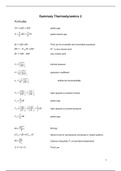Summary
Summary Thermodynamics 2
- Module
- Institution
- Book
This is a compact summary of the course Thermodynamics 2. Includes information from the lecture notes, the book and the study guide. Consists of all the formulas used in the course, a compact summary and a glossary. The book used for this course is Physical Chemistry 10th edition from Atkins and De...
[Show more]




